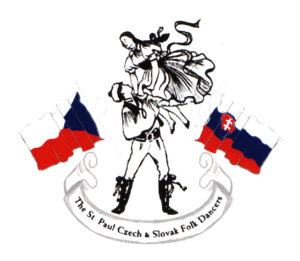 The St. Paul Czech and Slovak Folk Dancers
The St. Paul Czech and Slovak Folk Dancers
Are an ethnic dance group promoting the Bohemian ( Czech and Moravian), and Slovak heritage and culture.
Bohemia
Bohemia is the most western part of the Czech Republic. Neighbors include Germany to the north and west and Austria to the south. Located on a plateau surrounded by mountains, the climate is very much like Minnesota. Bohemia contains the largest city and capital, Prague.
Music from this region shows the influence of German culture and has a regional flavor since trades-people going from village to village would spread the songs of their home villages wherever they went, resulting in national dances like Furiant.
Moravia
East of Bohemia are the hills of Moravia, home of the vineyards that produce excellent Moravian wines. Moravia is bordered by Poland to the north and Austria to the south. The largest city in Moravia is Brno.
Music in the region includes fiddle bands, joined by the xylophone-like sound of the cimbala, or hammer dulcimer. Dances often include independent displays by the women and men, and have a slow section followed by a quick dance.
In the Valassko region at the edge of the Carpathian mountains, the natural produce includes hemp linen and wool. Leather was a symbol of wealth in some regions of the country. The more money you had, the longer or thicker your belt could be. Our Moravian men show off their wealth by wrapping their belts around their waists several times. Some of the Moravian men wear a handkerchief sticking out of their pocket. Tradition states that a young man presents that handkerchief to the girl of his choice after a dance. She takes it home and puts it under her pillow. If she dreams of the young man that night, he is the one she is destined to marry.
Slovakia
Slovakia became an independent republic on January 1st, 1993 after the “Velvet Divorce” from the Czech Republic. Neighbors include Poland to the north, the Ukraine to the east, and Hungary to the south. The capital city is Bratislava.
The lively tempos of the czardas originate in the lowlands. Simpler pastoral music, including the haunting sounds of fife and fujara, and accordians and concertinas, come from the highlands of the Tatra Mountains.
One of the loveliest features of Slovak kroje is the beautiful cutwork embroidery you see on the women’s sleeves. The men wore open bottomed sleeves. Predominant colors include black and gold.
Background
Our group was formed in 1962 to display Czech and Slovak culture through dance. Our costumes, or kroje, represent the dress of a number of different villages throughout both the Czech (Bohemia and Moravia) and the Slovak Republics.
Contact us (director@tancuj.org) for performances at festivals, conferences, and holiday celebrations. We tailor our educational and entertaining program to your needs.
